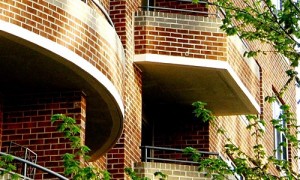Although William Penn’s surveyor may have envisioned a number of large, single-family homes when he designed the initial plans for Philadelphia, rowhouses have become the city’s dominant housing option, according to the Philadelphia Rowhouse Manual.
Rowhouses line streets throughout the city, from the bustling downtown areas of Society Hill, Old City, and Fitler Square, to more far-flung regions like the Northeast, Southwest Philadelphia, and Kensington. While rowhouses appeal to a lot of people, they are not for everyone. Here are some things to consider:
Lack of Yards and Lawns
Compared to single-family homes or even twin homes, a rowhouse typically offers very little when it comes to outdoor property. Most don’t have a front yard at all; only a simple stoop or a front porch. A back yard is more common, but it’s usually very small and often has concrete in lieu of grass.
But the home’s lack of yard isn’t necessarily a bad thing. In fact, it’s great if you dread yard work or are quite happy with just a small container garden or a petite patio set. But if you’re looking for a big yard for a swimming pool or for large outdoor gatherings, a rowhouse isn’t ideal.
Party Walls
Unless it’s the house on the end of the block, a rowhouse is typically between two shared walls or “party walls.” Depending on the thickness of the walls and how loud or quiet you and your neighbors are, party walls can be an issue. If you’re unlucky enough to have thin walls, you can hear music, TVs, and even conversations through the walls.
Party walls can also provide some benefit, however. Since you have two buildings on either side of the house, your home gets a bit of extra insulation from the elements. And if your walls are thick, all but the loudest sounds are muffled.
Space Issues
Space can be a big issue in rowhouses. The homes vary in size, from microscopic Trinities — three-story houses with a single room on each floor — to homes of more than 3,000 square feet. Some rowhouses have just a single story, while others are four stories tall or even higher. Older homes also typically don’t have a lot of storage space or closet space. With the right building permits, budget, and patience, however, you can add on to a rowhouse to make it better suit your needs.
Common Features
The features of a Philly rowhouse depends on when it was built and how it’s been maintained over the years. The earliest rowhomes range in size from a tiny (by today’s standards) 400 square feet to a quite large (by today’s standards) 7,000 square feet. The smallest early rowhouses often only have one entrance at the front, instead of a front and back door.
The “workingman’s houses,” built in neighborhoods in South Philly throughout the late 1800s, often feature shallow, tiny closets and a simple design. Rowhouses built in the 20th century in neighborhoods near the Philadelphia Museum of Art, the northeast and Mount Airy often include a small garage and a front porch, or a raised, closed-off entry. Larger rowhomes built after World War II often do have a small front yard with grass.
While rowhouses in Philadelphia are often small in size, they’re big on charm. The layout of many houses and the small or nonexistent yard area makes them an appealing pick for urbanites looking to get out of their apartments and condos.
Photo Source: Flickr
[cf]skyword_tracking_tag[/cf]







We visited my daughter in Pittsburgh when she was living in a similar type house that was relatively narrow, but had a small space on each side and a skinny yard in the back. It didn’t share walls, but I couldn’t get my Chrysler 300 between her and her neighbor! Lots of stairs, but also old style charm.
[…] lot of Philadelphia homes (especially rowhomes and townhouses) were built with small crawlspaces instead of full attics. These crawlspaces are […]
[…] lot of Philadelphia homes (especially rowhomes and townhouses) were built with small crawlspaces instead of full attics. These crawlspaces are […]
[…] lot of Philadelphia homes (especially rowhomes and townhouses) were built with small crawlspaces instead of full attics. These crawlspaces are […]
[…] lot of Philadelphia homes (especially rowhomes and townhouses) were built with small crawlspaces instead of full attics. These crawlspaces are […]
[…] rowhome roofs can be relatively small in size, when shingles age and you begin to experience leaks, repairs can […]
[…] rowhome roofs can be relatively small in size, when shingles age and you begin to experience leaks, repairs can […]
[…] rowhome roofs can be relatively small in size, when shingles age and you begin to experience leaks, repairs can […]
[…] rowhome roofs can be relatively small in size, when shingles age and you begin to experience leaks, repairs can […]
[…] of rowhouses in Philadelphia don’t come with attics, but instead have flat roofs. The process for insulating attic-free […]
[…] of rowhouses in Philadelphia don’t come with attics, but instead have flat roofs. The process for insulating attic-free […]
[…] of rowhouses in Philadelphia don’t come with attics, but instead have flat roofs. The process for insulating attic-free […]
[…] something a little closer to the ground, in a neighborhood that’s a little quieter, a unit in a Philadelphia rowhouse might be a better option. Rowhouses are located all over the city. While some are divided into […]
[…] something a little closer to the ground, in a neighborhood that’s a little quieter, a unit in a Philadelphia rowhouse might be a better option. Rowhouses are located all over the city. While some are divided into […]